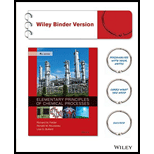
An aqueous waste stream leaving a process contains 10.0 wt% sulfuric acid and l kg nitric acid per kg sulfuric acid. The ?ow rate of sulfuric acid in the waste stream is 1000 kg/h. The acids are neutralized before being sent to a wastewater treatment facility by combining the waste stream with an aqueous slurry of solid calcium carbonate that contains 2 kg of recycled liquid per kg solid calcium carbonate. (The source of the recycled liquid will be given later in the process description.)
The following neutralization reactions occur in the reactor:
The sulfuric and nitric acids and calcium carbonate fed to the reactor are completely consumed. The carbon dioxide leaving the reactor is compressed to 30 atm absolute and 40°C and sent elsewhere in the plant. The remaining reactor ef?uents are sent to a crystallizer operating at 30°C, at which temperature the solubility of calcium sulfate is 2.0g CaSO4/1000 g H2O. Calcium sulfate crystals form in the crystallizer and all other species remain in solution.
The slurry leaving the crystallizer is ?ltered to produce (i) a ?lter cake containing 96% calcium sulfate crystals and the remainder entrained saturated calcium sulfate solution, and (ii) a ?ltrate solution saturated with CaSO4, at 30°C that also contains dissolved calcium nitrate. The ?ltrate is split, with a portion being recycled to mix with the solid calcium carbonate to form the slurry fed to the reactor, and the remainder being sent to the wastewater treatment facility.
- Draw and completely label a ?owchart for this process.
Want to see the full answer?
Check out a sample textbook solution
Chapter 6 Solutions
Elementary Principles of Chemical Processes, Binder Ready Version
Additional Engineering Textbook Solutions
Process Dynamics and Control, 4e
Elements of Chemical Reaction Engineering (5th Edition) (Prentice Hall International Series in the Physical and Chemical Engineering Sciences)
Starting out with Visual C# (4th Edition)
Introduction to Java Programming and Data Structures, Comprehensive Version (11th Edition)
Database Concepts (8th Edition)
Thinking Like an Engineer: An Active Learning Approach (4th Edition)
 Introduction to Chemical Engineering Thermodynami...Chemical EngineeringISBN:9781259696527Author:J.M. Smith Termodinamica en ingenieria quimica, Hendrick C Van Ness, Michael Abbott, Mark SwihartPublisher:McGraw-Hill Education
Introduction to Chemical Engineering Thermodynami...Chemical EngineeringISBN:9781259696527Author:J.M. Smith Termodinamica en ingenieria quimica, Hendrick C Van Ness, Michael Abbott, Mark SwihartPublisher:McGraw-Hill Education Elementary Principles of Chemical Processes, Bind...Chemical EngineeringISBN:9781118431221Author:Richard M. Felder, Ronald W. Rousseau, Lisa G. BullardPublisher:WILEY
Elementary Principles of Chemical Processes, Bind...Chemical EngineeringISBN:9781118431221Author:Richard M. Felder, Ronald W. Rousseau, Lisa G. BullardPublisher:WILEY Elements of Chemical Reaction Engineering (5th Ed...Chemical EngineeringISBN:9780133887518Author:H. Scott FoglerPublisher:Prentice Hall
Elements of Chemical Reaction Engineering (5th Ed...Chemical EngineeringISBN:9780133887518Author:H. Scott FoglerPublisher:Prentice Hall
 Industrial Plastics: Theory and ApplicationsChemical EngineeringISBN:9781285061238Author:Lokensgard, ErikPublisher:Delmar Cengage Learning
Industrial Plastics: Theory and ApplicationsChemical EngineeringISBN:9781285061238Author:Lokensgard, ErikPublisher:Delmar Cengage Learning Unit Operations of Chemical EngineeringChemical EngineeringISBN:9780072848236Author:Warren McCabe, Julian C. Smith, Peter HarriottPublisher:McGraw-Hill Companies, The
Unit Operations of Chemical EngineeringChemical EngineeringISBN:9780072848236Author:Warren McCabe, Julian C. Smith, Peter HarriottPublisher:McGraw-Hill Companies, The





